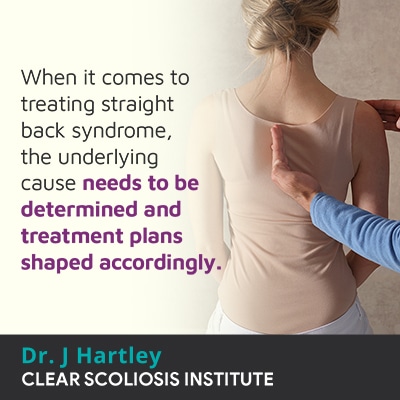
If the spine becomes excessively straight, this is contrary to its natural curved design. It's the spine's healthy curves that keep it flexible, strong, and able to handle stress from impact and movement. The position and alignment of the spine affects body position and posture, so one of the main effects of straight-back syndrome is postural deviation.
The spine's natural curves allow it to function optimally, but if the thoracic spine loses its healthy level of kyphosis and becomes excessively straight, this is known as straight back syndrome (SBS) and can be problematic.
Before defining and exploring straight-back syndrome, let's discuss the difference between healthy and unhealthy spinal curves.
There are different types of spinal curves, some healthy and some unhealthy.
A healthy spine will have an 'S' shape when viewed from either side, and this is because the spine is naturally curved at each of its main sections.

Each spinal section has its own unique roles to play in preserving spinal flexibility, strength, and function, and the health of each spinal section is dependent on the health of the others; if a single healthy spinal curve is lost, the biomechanics of the entire spine are affected.
If the spine's healthy curves are in place, its vertebrae (bones) are aligned, and adjacent vertebral bodies are separated by an intervertebral disc.
I'd like to briefly discuss the intervertebral discs because they are key spinal structures, and their deterioration is a contributing factor in the development of a number of spinal conditions, including straight back syndrome.
The spinal discs combine forces to enable flexibility, act as the spine's shock absorbers, give the spine structure as vertebral bodies attach to the disc in between, and provide cushioning between adjacent vertebrae to prevent friction and degeneration.
The discs are generally the first structures of the spine to start to deteriorate, and this can involve natural age-related spinal deterioration and/or the cumulative effect of not leading a spine-friendly lifestyle.
There is a healthy range of spinal curvature sizes, but when the size of a spinal curve falls beyond a normal range, the spine can become misaligned, and complications can occur.
As mentioned, the spine's natural curves are key to spinal health and function, and lordosis and kyphosis can refer both to healthy and unhealthy degrees of lordosis and kyphosis.
Lordosis refers to a type of spinal curvature that bends inwards in a standard 'C' shape, and kyphosis refers to a type of spinal curve that bends backwards in a reverse 'C' shape.
The spine's lordosis is found in the cervical and lumbar spinal sections, and kyphosis is found in the thoracic spine.
If a patient experiences a loss of cervical lordosis, the neck has become excessively straight, often referred to as military neck.
The cervical spine is important not only because it supports the weight of the neck, the head, and facilities the neck's range of motion, as the cervical spine contains the first seven vertebrae (C1 to C7), it connects the brain to the rest of the body; its health is important for brain-body communication.
If there is an issue in the cervical spine, it can cause a domino effect that extends the length of the entire spine; remember, as one long structure, the health of each spinal section depends on the health of the others.
A person's lumbar lordosis is important because the lower back has to support the weight of the trunk, the thoracic and cervical spinal sections above, and the lumbar vertebrae feel the effects of strenuous movements: bending, lifting, and twisting.
As mentioned, the thoracic spine is the largest spinal section, making it vulnerable to a number of conditions/issues, and if the thoracic spine's natural kyphosis is excessive or lost, problems will occur; as the thoracic cage encloses the heart and lungs, if the position of the thoracic cage is affected as the thoracic spine changes, it can cause cardiac and respiratory problems.
If the thoracic spine's kyphosis becomes excessive, with an exaggerated curve, this is thoracic hyperkyphosis, and a loss of kyphosis that makes the spine excessively straight is known as thoracic hypokyphosis.
So what is straight back syndrome? Straight back syndrome occurs when the spine has lost its natural thoracic kyphosis and become excessively straight; it's most commonly diagnosed as thoracic hypokyphosis, but can also be referred to simply as thoracic kyphosis and/or straight back syndrome.
Straight back syndrome causes the body's posture to shift forward, giving a pitched-forward appearance, making it difficult to remain standing for extended periods of time and/or to stand up straight.
It's not uncommon for people with straight back syndrome to become more stooped forward throughout the day, as it becomes more difficult to maintain an economical posture and gait.
While each case is unique, in addition to the stooping posture that tends to develop, the following are symptoms of straight back syndrome:

Some patients will need a cane or walker to assist in remaining upright and walking; because of the pitched-forward posture it causes, trunk weight can’t be evenly distributed over the pelvis and legs.
The forward posture causes a shift in the body's center of gravity, and that shift makes the body off balance and is also associated with changes to balance, coordination, and gait.
Muscles of the back can become sore and strained because they are trying to support and stabilize an excessively-straight spine, and muscle imbalances are also a complication of unnatural spinal curves as the spine's surrounding muscles struggle to counteract the development of an unhealthy curve, and/or the loss of a healthy curve.
Fatigue is common in straight back syndrome because the postural changes it causes makes it increasingly difficult to counteract the condition's uneven forces and maintain balance and an economical gait.
An additional complication that can develop, particularly if severe and/or if left untreated, is the development of forward head posture: when the body responds to the unnaturally-straight spine by shifting the neck and head forward.
Forward head posture increases strain on the cervical spine; it's estimated that if the neck shifts forward as little as one inch, it can increase the weight of the head by approximately 10 pounds, and this can cause neck pain, tension headaches, and sore neck, shoulder, and upper-back muscles.
When it comes to treating straight back syndrome, the underlying cause needs to be determined and treatment plans shaped accordingly.
Causes for straight back syndrome can include congenital abnormalities that include a malformed spine, degenerative disc disease, osteoporosis, ankylosing spondylitis, and spinal surgery.
Many patients benefit from a non-surgical conservative treatment approach that has the priority of restoring the spine's healthy curves while improving spinal flexibility, strength, and support.
Conservative treatment is also referred to as functional and/or chiropractic-centered, and through condition-specific chiropractic care, I can work towards impacting conditions on a structural level by applying a number or techniques and manual adjustments to reposition the most-affected vertebral bodies back into a neutral and healthy alignment.
Corrective bracing is an additional facet of treatment that can help by pushing the spine into a better position.
In addition, through a number of condition-specific exercises, stretches, and physical therapy, postural correction, increasing the spine's surrounding muscle strength, reversing patterns of muscle imbalance, and helping to stimulate certain areas of the brain for enhanced communication can also help.
A plumb line can be drawn through the center of the body and spine to determine its verticality, and if the spine is where it should be relative to that line, the body is balanced and symmetrical, but if that line shifts, as it does with the development of an unnatural spinal curve, a person’s natural center of gravity shifts, and the body has to expend extra energy to maintain balance and counteract an uneconomical gait.
When straight back syndrome is severe and/or is left untreated, a variety of clinical cardiovascular manifestations (cardiac disease, valvular heart disease, atrial septal defect, cardiac murmurs, and pseudo heart disease) can develop as the distance between the heart and the spine biomechanically decreases, and this can compress the spine, the heart, and other important organs.
When a diagnosis of straight back syndrome, aka thoracic kyphosis and/or thoracic hypokyphosis, is given, this means the thoracic spine has lost its natural backward-bending spinal curve, instead becoming excessively straight.
When the spine is too straight, it can cause a pitched-forward posture that gives the appearance of being stooped over, and this can make it difficult to stand up straight and/or remain standing for longer periods of time.
Here at the CLEAR Scoliosis Institute, many sbs patients have shown a positive response to non-surgical treatment options that include chiropractic care, spinal manipulation, physical therapy, corrective bracing, and a variety of condition-specific exercises and stretches.

CLEAR provides a unique and innovative way of understanding scoliosis. Sign up to receive facts and information you won’t find anywhere else.
